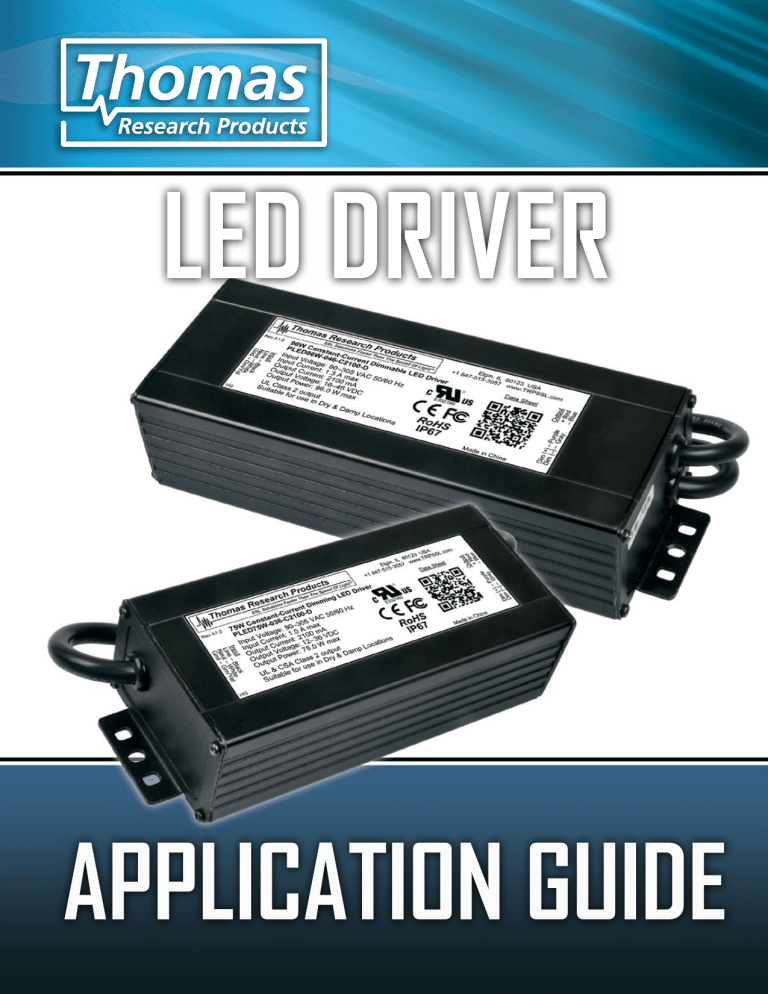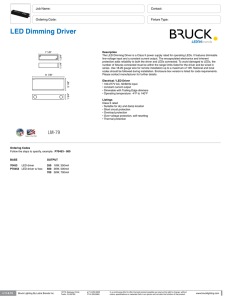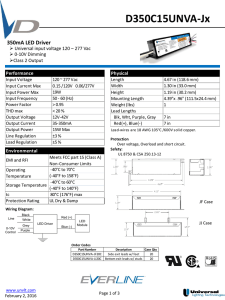LED Driver Application Guide

LED DRIVER
APPLICATION GUIDE
LED Driver Application Information
LED technology holds immense promise for the lighting industry, and society in general. It's also a great opportunity for OEMs. However, adopting the new technology require some adjustment. LEDs have their own issues. We hope to give you some advance help here. And additional information is available on our website FAQ page.
Design
1) Determining LED Load
It is important to match the LED driver to actual load of the LED light engine. While it seems more complex than simply matching up the wattage for the fluorescent ballast to a set of lamps, the effort pays off in higher performance.
For proper LED performance, determining the LED load and picking the appropriate driver is critical.
TRP has a document on our website FAQ page to help you. Find it here: Determining LED Load
2) Customized Drivers versus Programmables
There is a lot of interest in the market for programmable drivers. The thinking is that inventory is reduced if one product could be stocked at the OEM, programmed at the time of installation. However, this makes the driver design much more complex, and excessive handling is always risky. Plus it introduces cost and labor barriers to viability.
TRP can customize a driver's output, tuning the output current down to a specified level, on our normal manufacturing line. This offers very competitive benefits:
• No additional cost
• No additional lead time
• No NRE charges
• Does not require time and labor to program before installation
• Does not require re-submittal to UL
LED & Driver Basics
1) Why does the system need a driver?
A driver is usually always part of a system because most LEDs cannot be connected directly to the power supplied by the electric company. They need a more constant power supply. The majority of LEDs today operate on direct current (DC), while some do operate on alternating current (AC).
2) Does the dimmer dim or does the control do the dimming?
This depends on the type of dimming. Line voltage dimming changes the power to the system such that the system,
(including the LED Driver) can produce less light. In the case of 0-10V control, the control changes the separately wired dimming signal between 0-10V so that the LED Driver reads that signal and tells its output current to change proportionally.
3) What is forward voltage? Why is it important?
Forward voltage (Vf) is the voltage that the LED requires in order to run at a specific constant-current and produce a specific lumen output. It's important for determining the power requirements of the LED Light Engine.
4) How is input voltage different from Vf?
Input voltage is usually the voltage produced at the building to be fed to a lighting fixture; forward voltage is the characteristic of LED(s) that occurs when a current flows through it.
5) What are milliamps?
This is a measure of current, denoted as “mA.”
SSL Solutions Faster Than The Speed Of Light ®
6) Can a 700MA product use a 1000MA driver?
Typically no, but it depends on the LEDs used in the light engine, and how they are configured (in series or parallel).
Thermal management (which helps conduct heat from the LED to a heat sink, with sufficient surface area for the heat to be convected away) also is a factor. If you have a light engine meant to run at 700mA, and you drive it at 1000mA, the device will exhibit a shorter life and/or overheat and fail.
7) What is wattage?
It is the product of voltage times current. It is additive when calculating for a quantity of series/parallel LED strings.
8) You have 50 total watts, do you use a 50W driver or 75W?
Typically you can use 50W; however, whether you need to oversize the LED Driver to 75W may depend on other parameters associated with your system.
9) Does a driver get hot? Does it need to be mounted on metal to dissipate the heat?
Yes, a driver can get hot. The best way to dissipate the heat depends on other parameters associated with the system and its application environment.
10) Can you control the dimming with a non-LED rated dimmer?
No
11) Is a black driver different from a silver driver?
The difference to look for is if the case is metal or plastic. A metal case can help move more heat out of the driver to maximize its life. Black is generally a better radiator of heat, whether plastic or metal.
Dimming
1) What type of dimmers are compatible with TRP Drivers?
• Make sure you are using a current sinking type 0-10V dimming control.
• Make sure the 0-10V dimming control is rated properly for the load (if 5 drivers each with
10mA source current are hooked up, dimmer sink current will need to be rated for 50mA).
2) Can't I use your dimming drivers with a Triac dimmer?
Most of our drivers offer 0-10V dimming control. Phase control dimmers (including triac and ELV dimmers) are line voltage dimming controls, and work on a entirely different principle. They are most common in residential applications and only some commercial settings, while 0-10V dimmers are commonly used in commercial lighting.
TRP offers specific line voltage dimming versions of our LED20W, LED25W and LED40W drivers, please see the data sheets on our website for more information.
2) What issues are there with multiple drivers per dimmer?
If multiple drivers are used for one 0-10V dimming control, make sure all purple wires connected together and all gray wires connected together.
3) The green dimming wire is ground, right?
• Watch out for the few drivers that have the green/GND dimming wire – it really is the dimming return
“gray” wire equivalent, not earth ground equivalent.
• Any unused dimming leads should be capped off.
• Don’t route dimming leads with power leads to fixture.
3) Why doesn't the dimmer work when the TRP driver is connected?
If the driver is not properly selected for the load, dimming may appear like it is not working
(eg, turn completely off instead of dimming down).
4) Do you have a list of dimmers that are compatible with your drivers?
Not at this time. We are testing a variety of dimmers. Recommended are Leviton IP710 type dimmers.
For more data on TRP's dimming drivers, including proper wiring, please see our FAQ " LED Driver Dimming Guide ."
SSL Solutions Faster Than The Speed Of Light ®
SSL SOLUTIONS FASTER THAN THE SPEED OF LIGHT
®
Installation
1) Can I wire multiple drivers together?
We do not recommend it. The simplest solution is usually the best. It can not be done at all with 0-10V dimming. While some fixed-output drivers may be configured together on the output side to achieve the required forward voltage at the desired current of your LED light engine, not all can. It also makes wiring much more complex and problem-prone. However, multiple drivers can always be paralleled on the input voltage side.
2) Can I mount the driver on the heat sink in my fixture?
No. The issue is heat. Drivers are electronic devices which can be damaged by heat, as will the LED chips themselves. Our LED drivers are designed to maintain a safe operating temperature by convection, so they need some volume of space around them for cooling. Being in contact with a heatsink for the light engine may damage the driver. Also, avoid the oven effect of setting up your driver in the same sealed compartment as your LED light engine.
3) What is Hot Plugging? Can it damage my LEDs?
Connecting or disconnecting an energized LED Driver to a Light Engine (known as "hot plugging" in the electronics industry) has been shown to damage LEDs by the LED manufacturers. Hot plugging causes arcing transients when energized output leads of a driver contact the unpowered load connections. These transients can damage the LED Light engine load, as well as feedback into the LED driver and damage the output control circuitry. Also, an inrush current into the LED Light engine can occur, seriously damaging the LED Light engine. Essentially, a surge current to the LED Light engine is created as the load attempts to discharge the output capacitance of the LED Driver. We highly recommend making only un-energized connections; and for drivers that were recently energized into an open circuit condition, waiting at least 30 seconds to allow the output capacitance to discharge before connecting the LED Load!
Flicker
Flicker is a major question in the lighting industry at the moment. For many individuals, it is simply an annoyance; however, a link has been suggested between flicker and health problems. Some individuals, especially those with autism, see the flicker present in CFL lighting. Flicker can also be present with LED lighting under certain circumstances; however, there is much confusion surrounding the cause of it.
Flicker is a much larger problem with AC LED than standard DC-based LED systems. AC power cycles at approximately 60 Hz, or 60 times per second, while all LEDs are essentially
DC. For AC LED application, two banks of LEDs are switching back and forth--on or off--with each cycle, giving the appearance that the whole board is on. This rate of switching can be visible, as it often is with CFL.
Rectified AC LED switches at 120 Hz, at twice the rate of the power source. This makes the flicker less perceptible to the human eye. This eliminates the problem and gives the appearance of greater brightness, but it is somewhat less efficient than non-rectified LED.
For DC-based LED systems, flicker typically is a function of low-level, time-varying, line frequency AC signals riding upon the DC output. This effect is consistent with power conversion techniques used in power supply design. It is usually minimized in the design of the driver, but that adds cost and complexity. In critical applications, it's simply a mismatch between the light engine and the LED driver. This shows why you want to power LEDs with drivers designed for lighting, rather than power supplies originally intended for applications such as computers.
Is the driver defective if there is flickering in the light source?
The short answer is no. If you are using a dimmable driver, please check our Dimming Guide for proper wiring of the driver, with the proper type of dimming control. A flickering driver from TRP usually indicates improper application of a dimming driver. If you experience flicker, contact us to help determine the source and appropriate solutions.
If the information here (or on our FAQ page) doesn't completely answer your questions, feel free to contact us.
You can reach our Technical Customer Service at 847-515-3057 or tech.support@trpssl.com
1225 Bowes Rd. Elgin, IL 60123 USA T 847-515-3057 F 847-515-3047 www.trpssl.com
© 2015 Thomas Research Products. All rights reserved. Specifications subject to change without notice.
“SSL Soutions Faster Than The Speed Of Light” is a registered trademark.
TRPLEDFAQ (12/2015)


